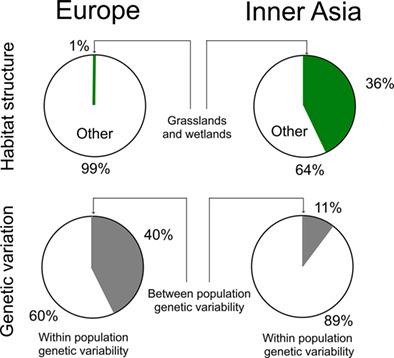当前位置:
X-MOL 学术
›
Insect Conserv. Divers.
›
论文详情
Our official English website, www.x-mol.net, welcomes your
feedback! (Note: you will need to create a separate account there.)
Comparison of genetic patterns between European and Asian populations of an endangered butterfly species
Insect Conservation and Diversity ( IF 3.2 ) Pub Date : 2020-09-13 , DOI: 10.1111/icad.12440 Ewa B. Śliwińska 1 , Rafał Martyka 1 , MichaŁ Woyciechowski 2 , Alexander Blinov 3 , Piotr Nowicki 2 , Christian Stettmer 4 , Joanna Kajzer‐Bonk 5 , Magdalena Witek 6 , Markus Bräu 7 , Patrick Gros 8 , Michael MÜhlenberg 9 , Jolanta Slowik 9 , Piotr Tryjanowski 10 , Josef Settele 11, 12
中文翻译:

欧洲和亚洲一种濒临灭绝的蝴蝶种群的遗传模式比较
更新日期:2020-09-13
Insect Conservation and Diversity ( IF 3.2 ) Pub Date : 2020-09-13 , DOI: 10.1111/icad.12440 Ewa B. Śliwińska 1 , Rafał Martyka 1 , MichaŁ Woyciechowski 2 , Alexander Blinov 3 , Piotr Nowicki 2 , Christian Stettmer 4 , Joanna Kajzer‐Bonk 5 , Magdalena Witek 6 , Markus Bräu 7 , Patrick Gros 8 , Michael MÜhlenberg 9 , Jolanta Slowik 9 , Piotr Tryjanowski 10 , Josef Settele 11, 12
Affiliation

|
- Less transformed and managed grassland habitats in Asia serve as a good frame of reference for studies on demographics and ecological situations of grassland species in Europe. In this study, using AFLPs (transposon insertion display), we compared the genetic structures of populations of the endangered and highly specialised scarce large blue (Phengaris teleius, Bergsträsser, 1779) butterfly from Europe (Germany, Poland, and Ukraine) and Asia (Siberia and Mongolia).
- There are no differences in levels of intra‐population genetic variability between European and Asian P. teleius populations. Nevertheless, we found significantly higher genetic differentiation (wider scattering) among European populations than among Asian populations. All examined Eurasian populations were admixed, except for those from the Bavarian region (Germany) where an atypical genetic structure was observed for P. teleius. Individual membership probabilities to a population were higher and more variable among European populations than among Asian populations. Comparison of genetic spatial structures revealed an isolation‐by‐distance effect in both European and Asian populations. Genetic autocorrelation analysis showed that significant dissimilarity among individuals first appeared at a distance of 1800 km at Asian sites, but at only 400 km at European sites.
- The observed P. teleius genetic structure reveals substantial differences in the quality of connectivity among European and Asian populations, which favour Asian populations. It suggests that differences between European and Asian P. teleius population genetic structures have the origin in differences in habitat structures, emphasising the impact of habitat fragmentation on animal movement in Europe.
中文翻译:

欧洲和亚洲一种濒临灭绝的蝴蝶种群的遗传模式比较
- 在亚洲,较少改造和管理的草地栖息地为研究欧洲草地物种的人口统计和生态状况提供了良好的参考框架。在这项研究中,我们使用AFLP(转座子插入显示),比较了欧洲(德国,波兰和乌克兰)和亚洲(德国)濒临灭绝和高度专业化的稀有大蓝蝶(Phengaris teleius,Bergsträsser,1779)的种群遗传结构。西伯利亚和蒙古)。
- 欧洲和亚洲远缘体育种群的种群内遗传变异水平没有差异。尽管如此,我们发现欧洲人群中的遗传分化(分散程度更大)远高于亚洲人群。除了来自巴伐利亚地区(德国)的P. teleius的非典型遗传结构外,所有检查过的欧亚种群都混合在一起。与亚洲人群相比,欧洲人群中个体对人口的隶属概率更高,且差异更大。遗传空间结构的比较揭示了欧洲和亚洲人口的按距离隔离效应。遗传自相关分析表明,个体之间的显着差异最早出现在亚洲站点1800 km处,而欧洲站点仅400 km。
- 观察到的P. teleius遗传结构表明,欧洲和亚洲人口之间的连通质量存在很大差异,这有利于亚洲人口。这表明欧洲和亚洲的P. teleius种群遗传结构之间的差异起源于栖息地结构的差异,强调了栖息地破碎化对欧洲动物运动的影响。










































 京公网安备 11010802027423号
京公网安备 11010802027423号